Tradescantia flower: reproduction and care at home
Tradescantia unites more than 30 varieties of plants of the commeline family. The birthplace of the flower is considered to be the temperate and tropical belt of America, and it owes its name to the gardener of the English king Charles I, John Tradescant the elder and his son.
Content:
- Description and varieties of indoor flower
- Growing conditions
- Watering and feeding
- Transfer: terms and rules
- When and how to trim correctly?
- How to propagate Tradescantia at home?
- Disease and pest control
Description and varieties of indoor flower
Tradescantia unites more than 30 plant species of the commeline family. The homeland of the flower is considered to be the temperate and tropical belt of America, and it owes its name to the gardener of the English king Charles I, John Tradescant the elder and his son.
Due to its susceptibility to temperature changes, Tradescantia is more suitable for indoor growing.
It is a perennial bush with sprawling shoots with white or purple flowers, rarely flowers have other shades. Flowering does not last long, about 24 hours, but the fallen inflorescence is quickly replaced by the following. The general flowering time frame is long, from 5 to 6 months. When planted in small groups in pots or aquariums, it will effectively complement the interior of a house or winter garden.
The plant is distinguished by a considerable species diversity, but the following varieties of Tradescantia are in demand among gardeners:
- Hanging Tradescantia. In the literature, it is also called zebra-like, because of the silvery-green stripes on the outside of the leaves.
- Virginia Tradescantia - many hybrid varieties were created on its basis. The leaves are long, pointed, the inflorescence is umbellate and lush, with blue flowers.
- Tradescantia Anderson. It belongs to hybrid varieties adapted for planting on open ground, used for garden and park design. Leaves are green, purple, yellow. The inflorescences have a gradation of shades from sky-blue to pink-lilac.
- Tradescantia is white-flowered. Differs in unusual sharp leaves on creeping shoots, inflorescences are small, white.
- Tradescantia Blossfeld. Shoots are creeping, with a reddish tint, the bottom of the leaf is purple, the inflorescence is pale pink. The variegated variety has longitudinal yellow stripes on the leaves.
- Tradescantia myrtle. Shoots are purple-scarlet, with a tint of green, rounded leaves. The variegated plant is characterized by stripes.
- Sillamontana Tradescantia. Stems and leaves are covered with white fluff, which protects from sunlight, and disappears with a lack of it.
- Tradescantia rheo or covered. The leaves are olive-colored and xiphoid. It is formed into a small bush, it is in demand as an ornamental plant for the home.
- Small-leaved Tradescantia is the smallest species, it is distinguished by small green leaves with dark spots.
Important! Some types of flowers are poisonous, so after contact or processing of the plant, hands should be immediately washed under running water.
Growing conditions
What conditions do the plant need:
- Temperature conditions. The temperature that stimulates flower growth should not exceed 24-26 degrees in the spring-summer period and 10-12 in the cold season.At low temperatures, the shoots of Tradescantia stretch out and the flower loses its varietal dignity. In this case, the shoots of the bush have to be cut off.
- Humidity. The relative humidity value, which is comfortable for the plant, is 60%. With such a mark, to prevent rotting of the root system, the soil in the pot must be periodically gently loosened.
- Lighting... Well-lit places are most favorable for the growth of Tradescantia, but it is better to avoid direct sunlight - it can harm the delicate leaves. With a lack of light, the leaves of the flower become faded, varietal differences are lost.
- The soil. You can use a store-bought substrate or prepare the mixture yourself. To do this, you need to take one part of sand, two parts of black soil or soil from a forest belt, a garden, one part of sod land and one part of humus soil.
Important! When self-preparing a mixture for indoor flowers, all components must be warmed up in the oven or frozen. This is done in order to kill harmful microorganisms and parasites.
Watering and feeding
Home care for a Tradescantia flower is primarily based on adherence to the watering regime and feeding:
- Tradescantia is hygrophilous, and in a period of low humidity (spring-summer) requires special attention. It is better to water it with purified water at room temperature or settled tap water every 2-3 days. A sign of a lack of moisture is a dry top layer of the earth. In cold weather, the schedule changes - the flower should be watered every 3-4 days.
- The plant needs mineral and nutritional components during the period of intensive growth - in spring and summer. Often it is not necessary to feed the flower, it is enough 1 time in 14 days, changing the supplements on an organic basis with mineral ones.
Transfer: terms and rules
Transplanting Tradescantia is carried out immediately after the plant has overwintered. Young, growing plants require an annual transplant, and an adult plant can be transplanted no more than once every 2-3 years.
In the cold period, even with careful care, the roots partially dry out, and the plant can stretch out strongly, change color and fade.
The presence of these signs requires an urgent flower transplant. Among flower growers, the method of pinching shoots is common so that Tradescantia does not lose its bush shape. You can do without pinching, letting the flower stretch out. After that, the cuttings that have grown in 3 years are cut and prepared for planting in the ground.
For transplants use a suitable store substrate, or you can prepare the ground for transplanting Tradescantia yourself. This will require deciduous soil, humus, turf soil and sand in a ratio of 2: 1: 1: 0.5. But before use, it is recommended to bake the mixture in the oven to get rid of parasites and fungi. After that, place the resulting substrate in pots with a pre-filled drainage (you can use expanded clay medium fraction) and use for planting.
When and how to trim correctly?
When and how to properly trim Tradescantia? Pruning, like transplanting, is best done after the plant has overwintered, in early spring. What is it for:
- To maintain the aesthetic appearance and improve the bushiness of the flower.
- If the plant is already old, and the stems of the shoots are too long and too bare.
Usually, pruning is combined with transplantation and reproduction. To use a stalk for propagation of a plant, it must be cut off at a distance of 8 cm from the top and placed in a container of water. As soon as the cuttings give roots, they can be planted 3-4 units in a prepared substrate with drainage.
How to propagate Tradescantia at home?
There are three effective ways to breed Tradescantia:
- Cuttings... To do this, it is necessary to cut off from the top of the bush several young 10-centimeter branches with well-developed internodes and place them in a container with water until the roots appear.The young plant is now ready to be planted in the prepared wet substrate. In the first 5-7 days, an unrooted flower requires diffused light, sufficiently moist soil and a comfortable temperature of no higher than 18 degrees.
- Dividing the bush... This is a very simple way to propagate Tradescantia, suitable even for an inexperienced grower. In the process of transplanting, the plant extracted together with a lump of earth should be carefully disassembled into 3-4 parts without damaging the roots. In the end, you get a few bushes, ready for the classic planting.
- Seed reproduction. At the end of winter, seeds are sown under greenhouse conditions in a mixture of peat and sand. Comfortable temperature - 20 degrees. To regulate humidity and air circulation, the seedlings must be ventilated and sprayed with a spray bottle. The flowering period when propagated by seeds occurs after 3 years.
Disease and pest control
Despite its unpretentiousness, with improper care, Tradescantia is prone to the appearance of diseases that adversely affect the general appearance of the bush. Signs of diseases and mistakes when caring for a flower:
- Drying of the tips of the leaves - indicates insufficient air humidity.
- Yellowing of the leaves - the plant has little moisture.
- Shoots grow, the leaves do not grow and fall off, they lose their characteristic stripes - a lack of light.
- Blackening of the leaves indicates rotting.
- Flowering does not occur for a long time or there is no flowering at all - excess organic fertilizer.
A diseased plant can become a source of disease for indoor and outdoor tradescantia. In addition to being damaged by rot, it is susceptible to attack aphids, spider mites, thrips. To prevent the appearance of rot, it is enough to drain the remaining water from the sump and follow the rules of agricultural technology.
Tip: to rejuvenate Tradescantia before the winter cold and improve the aesthetic appearance, transplant the flower.
Insects attack the lower parts of the plant, changing the appearance and affecting other flowers. To combat pests, use a soap solution, an infusion of garlic, and with a large area of damage (for example, in a garden), you cannot do without spraying insecticidal preparations... A pronounced positive effect in the fight against insects and slugs is noted after treatment with Aktellik, Decis, Karate and preparations based on permethrin.
Maintaining comfortable conditions and proper care at home will enable Tradescantia to fully develop and delight with lush flowering. A well-groomed plant will always delight and decorate the house at any time of the year.
More information can be found in the video:



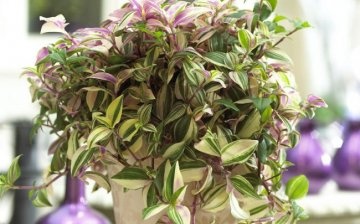
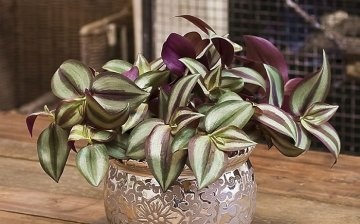
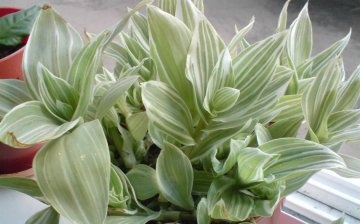

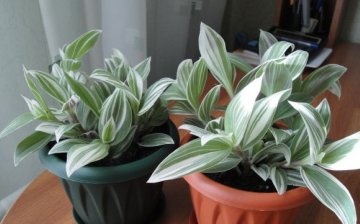







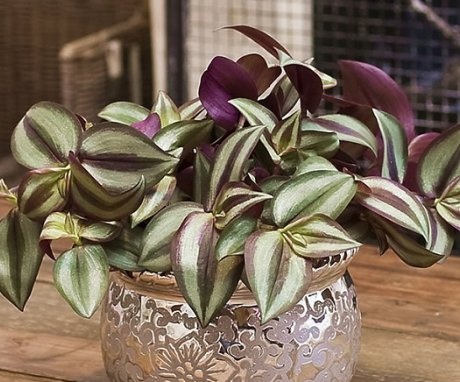
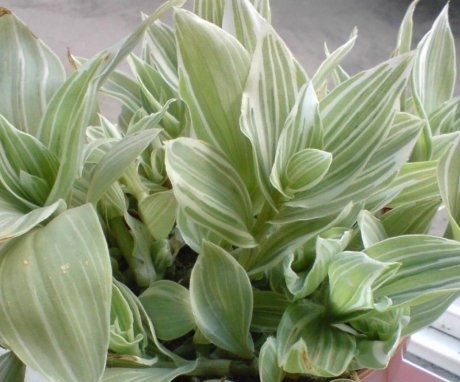
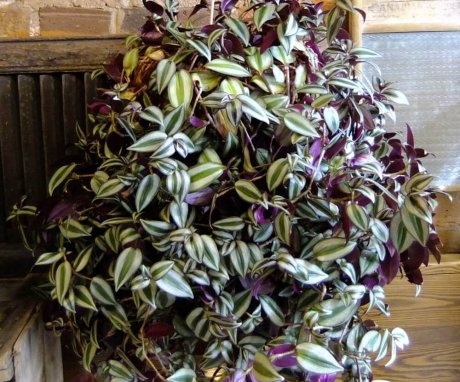
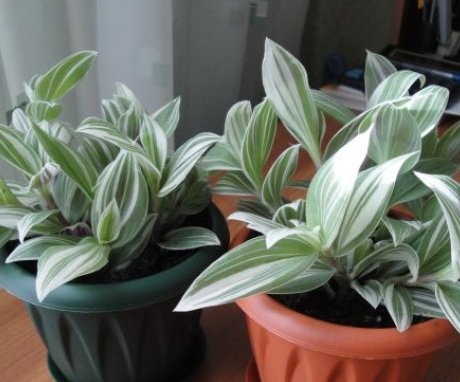
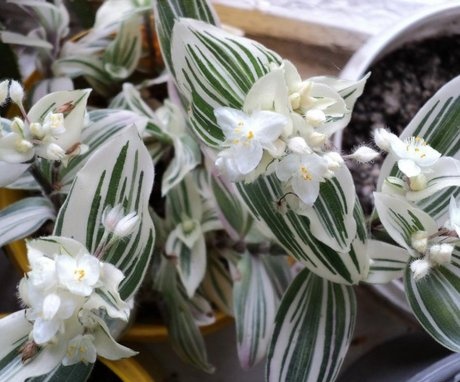
Tradescantia is a very pretty plant and gives dense vegetation, but this, in addition to aesthetics, also creates difficulties - rubbing the numerous leaves from dust turns into an epic, and when transplanting, you sweat all over while you pick it out.